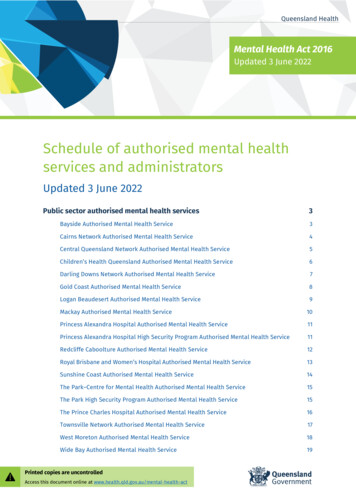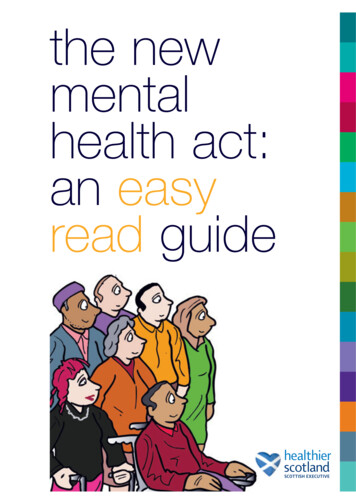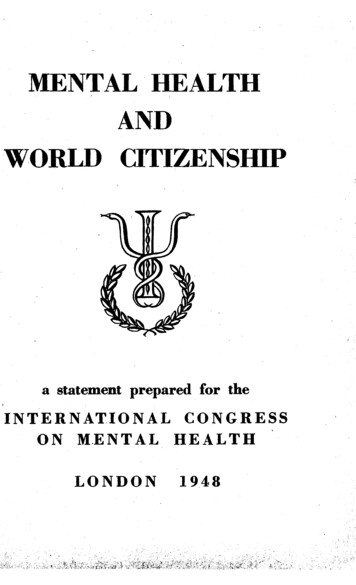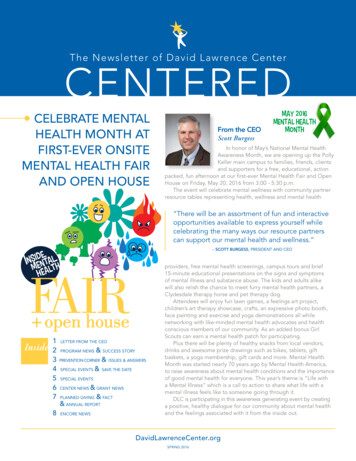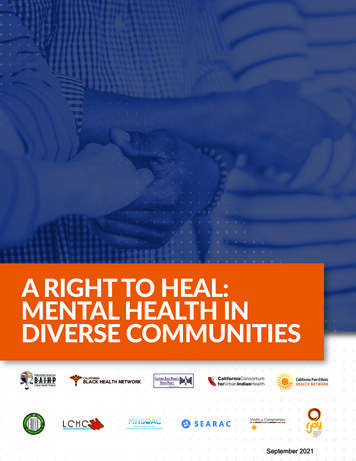
Transcription
A RIGHT TO HEAL:MENTAL HEALTH INDIVERSE COMMUNITIESSeptember 2021
Table of te of Community7Statewide Themes913State RecommendationsConversation Highlights and Recommendations from the Five Local Listening Sessions Reimagining Black Mental Health in Alameda County (Black/African-American/African Ancestry)19Advocating for Hmong Mental Health Needs in Butte County (Southeast Asian)20Advocacy for American Indian Health and Equity in Kern County (American Indian)21Mental Health Matters (Latino and Migrant Indigenous Residents)23Mental Health Matters: Culture as a Social Determinant of Health (Multicultural)24Detailed Overview of the Five Counties and Local Listening Sessions Alameda County Profile26Alameda County Listening Session: Reimagining Black Mental Health (Black/African-American/African Ancestry)28Butte County Profile31Butte County Listening Session: Advocating for Hmong Mental Health Needs (Southeast Asian)32Kern County Profile36Kern County Listening Session: The Advocacy for American Indian Health andEquity in Kern County Conference (American Indian)37 Kern County Listening Session: Mental Health Matters (Latino and Migrant Indigenous Residents)42Los Angeles County Profile46Los Angeles County Listening Session: Mental Health Matters: Culture as a Social Determinant (Multicultural)47Appendix I: 2021 Legislative and Policy Agenda52AuthorsThe California Pan-Ethnic Health NetworkThe California Black Women’s Health ProjectThe California Black Health NetworkRestorative Justice for Oakland YouthThe Southeast Asia Resource Action CenterThe Hmong Cultural Center of Butte CountyThe California Consortium for Urban Indian HealthThe Bakersfield American Indian Health ProjectThe Latino Coalition for a Healthy CaliforniaVisión y Compromiso
AcknowledgmentsThe California Pan-Ethnic Health Network (CPEHN) would like to thank all our partners and Listening Session Participantswho contributed to this work. It is because of the safe spaces that were created, that there was a willingness and honestyabout the experiences our communities have gone through while navigating mental health institutions. We thank you forsharing your experiences, energy and time. Your stories matter and deserve to be shared.IntroductionIn the early 2000s, mental health consumers, family members, and providers banded together to gather signatures,advocate for, and ultimately propel the passage of Proposition 63, the Mental Health Services Act (MHSA), in 2004. Thepurpose of the MHSA was to provide an infusion of funds that would expand and transform the public mental healthsystem in order to become 1) wellness, recovery, and resiliency focused, 2) consumer and family driven, 3) integrated, 4)culturally responsive, and 5) collaborative with the community. This advocacy effort and the MHSA itself arose out of amental health system that was underfunded, illness driven, and clinician directed with minimal consideration for consumers,their families, stakeholders in general, and particularly communities of color.“What is mental health? What is a mental health service? What could it be?”- Reimagining Black Mental Health ParticipantMHSA Programs and ExpendituresThe MHSA was designed to fund the full spectrum of mental health services. To this end, the Act set forth five (5)components for funding, three of which result in ongoing revenue. Community Services and Supports (CSS) is the largest of the MHSA components and provides funding for those withthe most significant mental health needs. It is approximately 85% of a County’s MHSA allocation and at least half ofthe CSS funding must go towards Full Service Partnership programs, which provide “whatever it takes” to supportindividuals who are experiencing homelessness, crisis and hospitalization, foster care or emancipation form foster care,criminal justice involvement, and/or other institutionalization. Prevention and Early Intervention (PEI) funds are slated for programs to prevent the development or progression of amental health issue and are generally 10% of the MHSA allocation. PEI funds provide prevention, early intervention,suicide prevention, stigma discrimination and reduction, and access and linkage services; at least 50% of PEI fundsmust be spent on children and youth. Innovation (INN) provides approximately 5% of a county’s allocation to pilot new interventions for a period of 3-5years. These projects must be approved by the Mental Health Services Oversight and Accountability Commission(MHSOAC) and must contribute to learning.The MHSA also set forth two (2) time-limited funds that provided funding for up to 10 years including Workforce3
Education and Training (WET) to support workforce development, and Capital Facilities and Technological Needs (CFTN) forinfrastructure. Currently, counties can choose to allocate a portion of CSS towards CFTN or WET given that the dedicated10 year allocations have expired. In addition, 65 million was allocated to launch the California Reducing Disparities Project(CRPD) in 2009, which identifies and alleviates disparities in mental health for five priority populations: African American,Asian and Pacific Islander, Latino, LGBTQ , and Native American.One of the benefits of the MHSA was that it provided some flexibility with funding that did not have the same restrictionsas Medi-Cal or other federal funding. However, most counties use a portion of their MHSA funds as the local contributionfor the Short-Doyle Medi-Cal specialty mental health program. This allows for MHSA funds to be used to leverageadditional federal Medi-Cal dollars and results in increased funding for mental health services (e.g., two dollars of service forevery one MHSA dollar expended). However, this practice also obligates counties to comply with Medi-Cal requirementsfor those MHSA expenditures, which may not always align with the spirit of the MHSA. Counties may be incentivized touse more of their dollars for Medi-Cal match instead of services not billable or matchable by Medi-Cal, like communitydefined services or services focused on a family or community rather than an individual. Additionally, this can make it harderfor community members to participate in and influence the MHSA planning process because they must also have someunderstanding of the Medi-Cal specialty mental health rules to fully participate.Most MHSA dollars are allocated directly to county mental health systems. The County Behavioral Health Departmentsalso serve as the Mental Health Plan (MHP) that provides specialty mental health services through the Short-Doyle MediCal program for people who meet the criteria for a serious or severe mental health issue.1 Mental health care for mild tomoderate needs, which became a consistent health care benefit as a result of the Affordable Care Act, is generally managedby an individual’s Medi-Cal managed care plan. This level of care can be a tremendous resource, and it may also complicateboth service access and CPP participation. Community members may not know whether to access mental health benefitsthrough the County mental health system or some other mechanism, and CPP participants must understand which of thesebenefits may be relevant to the CPP process and which may not be.MHSA Community Program PlanningThe passage of the MHSA in 2004 ushered in new opportunities for stakeholders to plan, design, implement, and evaluateprograms and services funded by the MHSA. The original purpose of the community planning process (CPP) was codified inthe California Welfare Institutions Code:“Planning for services shall be consistent with the philosophy, principles and practices of the Recovery Vision for mentalhealth consumers: To promote concepts key to the recovery for individuals who have mental illness -- hope, personal empowerment,respect, social connections, self-responsibility, and self-determination. To promote consumer-operated services as a way to support recovery. To reflect the cultural, ethnic, and racial diversity of mental health consumers. To plan for each consumer’s individual needs.”2According to Medi-Cal, a person would meet medical necessity for specialty mental health services if they had both a diagnosis of a serious mental illness and significant functional impairments as a result.1CA WIC Section 7, 5813.5 (d)2A Right to Heal4
The MHSA also allows for county mental health programs and state administrative funds to support consumers,families, and other stakeholders to participate in the CPP process and to ensure that state and county agencies give fullconsideration to stakeholder concerns about quality, structure of service delivery, and access to care.“My anxiety sits on my shoulder while I write/ And instead of shrugging her off/ I learn to askher what she wants to say/ Most days she wants to be written free/ To dissolve into bliss.”– Danyeli Rodriguez Del OrbeWith this mandate, communities came together with state and local governments and envisioned a wellness andrecovery focused mental health system that centered the experiences and expertise of consumers, their families, andtheir communities. From these efforts, a redesigned mental health system emerged that included Full Service Partnershipprograms in every county, in addition to other Community Services and Supports; prevention and early intervention effortsthat did not require someone to be “ill” in order to receive support; and people with lived experience were listened to asadvocates and employed throughout the system. While counties and the State attempted to engage with and provideservices for Black, Indigenous, People of Color (BIPOC) and their communities over the past fifteen (15) years, the MHSAhas not resulted in adequate participation within the MHSA for BIPOC communities, in terms of community programplanning (CPP) and service delivery.While there were initial efforts to engage with myriad MHSA stakeholders, theseefforts have dwindled over time, which disproportionately affects BIPOC communities and their ability to advocate on theirown behalf.“They have to effectively demonstrate that they’re concerned for the people seeking servicesand that they want to help people achieve wellbeing.”- Mental Health Matters ParticipantWhile the MHSA has resulted in some additional opportunities for BIPOC communities, it has largely been segregated fromthe mental health system overall. In many counties, there is some sort of MHSA committee that leads the CPP process andactivities, and there are separate committees or discussions that focus on BIPOC communities. In many communities, thislimits BIPOC stakeholders from influencing the overall CPP process and resulting MHSA Program and Expenditure Plans.One outcome of this type of siloing is that many counties fund Prevention and Early Intervention (PEI) programs that offerculturally specific programming, but those same culturally responsive principles are rarely applied to treatment servicesfunded by the Community Services and Supports component of the MHSA.ApproachFounded in 1992, CPEHN’s mission is to advance health equity by advocating for public policies and sufficient resourcesto address the needs of communities of color in California. As an organization, CPEHN was founded on the premise thatdiverse racial and ethnic communities can and should come together in support of a unified health agenda – inclusive ofphysical, mental, and oral health access, services, and quality – that would support a collective vision as well as amplifythe unique needs of each community. Four culturally-specific statewide organizations representing the African American,5
Asian and Pacific Islander, Latino, and Native American communities came together in service of their collective vision tocreate CPEHN. CPEHN and our partner organizations work to advance and support the overall health needs of BIPOCcommunities by building the capacity of our communities and community-based organizations to advocate on our ownbehalf. As advocacy organizations, we have been entrusted to work with and for our own communities towards greaterhealth and mental health equity. Inherent in our roots is the foundation of partnership within our communities and aninterdependent relationship between state and local level partners and policy efforts. As a part of or organizing efforts,we strive to gather and amplify the opportunity for local community-based organizations who have long served theseunderserved groups to provide their expertise in developing policies that close these disparities. We equip them to directlyadvocate locally, provide research and data to inform the conversation, and amplify their voices at the state level.In 2020, the Mental Health Services Oversight and Accountability Commission (MHSOAC) contracted with CPEHNfor three years in order to engage “Diverse Racial and Ethnic Communities” and build the capacity of local communitymembers, advocates, community-based organizations, and trusted representatives to engage with their local publicmental health system. Given that the majority of MHSA funds for programs and services are decided locally through alegislatively defined community program planning (CPP) process, there is tremendous opportunity to influence not onlythe way in which the CPP process occurs but also the outcomes of what programs and services are funded and how.This initiative seeks to: 1) equip local advocates and communities to participate in and influence MHSA decision-makingthrough leadership and advocacy development as well as 2) promote openness and accountability from MHSA staff andpublic officials to listen, seek to understand, and incorporate our perspectives into MHSA plans and funding allocations. Bytaking this approach, we increase access to the democratic process, ensuring that communities who have historically beenmarginalized are the agents calling for change.Since our inception, CPEHN’s approach to statewide community engagement has been to amplify the voices ofmultiple BIPOC communities of color by bringing together statewide partners with local partners to strengthenopportunities for advocacy cohesion, policy change, and strengthened regional/local impact. To this end, statewideagencies worked with local partner agencies to prepare local advocates and communities on how to participate andinfluence MHSA decision-making and how to support community members' discussion of mental health needs from asystem perspective.StatewideLocalPartnerPartnerPopulation ofFocusBlack/African AmericanLocationEventReimagining BlackTotalParticipantsCalifornia BlackHealth NetworkRestorative Justice forOakland YouthCaliforniaConsortium forUrban Indian HealthBakersfield AmericanIndian Health ProjectAmerican IndianKernAdvocacy for AmericanIndian Health andEquity109Latino Coalition for aHealthy CaliforniaVisión yCompromisoLatino and MigrantIndigenous ResidentsKernMental health Matters73Southeast AsiaResource ActionCenterHmongCommunity centerSoutheast AsianButteAdvocating forHmong Mental HealthNeeds163CaliforniaPan-Ethnic HealthNetworkCalifornia BlackWomen’s HealthProjectMulti-culturalLos AngelesMental HealthMatters: Culture as aSocial Determinant140A Right to Heal/African-AncestryAlamedaMental Health2046
Across the state, statewide partners worked with local organizations to convene 689 community members at in-person andvirtual listening sessions in Alameda, Kern, Butte, and Los Angeles counties. The listening sessions were an opportunity toexplore how BIPOC communities express their cultural perceptions of mental health and hear about their experiences withthe mental health systems.From targeted MHSA education advocacy events created to inspire and build momentum for stakeholders to participatemore with their local public mental health system, to expansive Land Acknowledgments that reflected upon the impactof settler colonialism, these culturally responsive events embodied both the spirit of advocacy and the wisdom of theirrespective communities.Participants were invited to share about their personal experiences trying to access care in the local mental health system,explore barriers to care, and openly discuss how structural racism, stigma, and cultural identity play a role in mental healthcare. Educational opportunities around the MHSA and CPP were provided and suggestions for improvement beyond betteroutreach engagement were encouraged.These life-affirming events created space for dialogue that was infused with cultural healing and artistic expressiveexperiences like guided meditations, breath work, spoken word, drumming and other musical performances. Below areconversation highlights and recommendations that emerged from the listening sessions and local events.State of the CommunityCalifornia is the most diverse and populous state in the nation with almost 40 million residents, and no one groupthat constitutes a racial or ethnic majority. Almost 25 million California residents (63%) are from communities ofcolor.3California Population by Race/EthnicityOther0.3%Pacific Islander0.4%American Indian orAlaskan Native0.4%MultiracialBlackAsianWhiteLatinxMedi-Cal Enrollment by Race/EthnicityNative Americanor Alaskan NativeBlackAsian or PacificIslander3%5.5%14.3%37.3%0.4%7.1%9.4%Not Reported17.3%White17.4%Latinx48.4%39.1%US Census, 20203A Right to Heal7
“Living in poor Black communities, there was just not that language, or the information given tous [about mental health].”-Reimagining Black Mental Health ParticipantApproximately 46% of Californians speak a language other than English at home, and 18% of those older than age 5 havelimited English proficiency.4 Additionally, California has the largest proportion of immigrants of any state in the nation,at 27%.5 More than one-third of Californians (13.6 million) are enrolled in the Medi-Cal program and receive publiclyfunded health insurance, and 77% of Medi-Cal recipients are people of color.6The National Survey on Drug Use and Health estimates that 21% of the population has a mental health issue and 5% hasa serious mental health issue.7 While there is data that attempts to disaggregate prevalence estimates by race/ethnicity,the data collected are not grounded in any cultural framework and dramatically underestimates the rate of mental healthissues in communities of color. Communities of color experience increased risk of mental health issues as a result ofthe effects of experiencing both interpersonal and institutional racism and oppression. As the country faces an everevolving pandemic and a growing call to fix the deeply embedded systemic and structural discrimination faced by racially,ethnically, culturally, and linguistically diverse communities, it is clear that structural and institutional racism are the keyissues impacting the mental health and physical health of communities. This includes the individual toll that racism andoppression have on individuals and their communities as well as the structural and systemic barriers that impede access tocare, result in culturally inappropriate services, and drive poorer mental health outcomes. At the individual level, individualsof color experience an increased risk of depression, anxiety, and other mental health problems that result from the toll thatexposure to racism takes on a person. This includes the effects of micro-aggressions and overt racism; the hypervigilanceand associated stress that results from the continuous fear of danger for oneself, loved ones, and community; and theongoing grief and trauma reactions that come from witnessing violence perpetrated upon other people of color.Over the past year, BIPOC communities across the state shared their perspectives on mental health issues affecting theircommunities, including the variety of challenges related to access, with language and other barriers deterring individualsfrom seeking treatment either because they are not aware of available services, due to limited culturally and linguisticallyappropriate outreach, or because they do not feel they can adequately communicate with or be understood by their mentalhealth providers. For some BIPOC communities, even the stigmatization of mental illness is so pervasive it prevents themfrom attempting to access care, let alone experience the quality of care. Below is a summary of key themes and issuesraised by BIPOC communities in the listening sessions hosted by CPEHN and statewide partners.“I know there are a lot of services and resources in Butte County, but I’m not sure where to seekhelp. Some people are afraid of a provider’s judgment on an individual, so we don’t plan or lookfor help with services.”- Advocating for Hmong Mental Health Needs ParticipantIbid.4Public Policy Institute of California. California’s Population. Just the Facts, March 2021. Retrieved from: ation/5California Department of Health Care Services, Medi-Cal Monthly Eligible Fast Facts, April 2021. Retrieved from: cuments/FastFacts-January2021.pdf6Substance Abuse and Mental Health Services Administration, 2019 National Survey on Drug Use and Health. Retrieved from: illness78
Statewide Themes“La ayuda existe pero necesitamos luchar mucho para conseguirla.”- Mental Health Matters ParticipantAccess: People of color, their loved ones, and community experience barriers in accessing mental health services that gobeyond stigma within the community itself and include complex access portals and pathways; lack of culturally responsiveoutreach; and fear that the process of asking for help or attempting to obtain services for oneself or a loved one maybe dangerous or result in harm, especially in times of crisis. These delays in access to care are generally associated withcontinued worsening of the mental health issue.Initial Access: Public mental health services across California are difficult to access, and each local mental health systemhas its own access portal and processes as well as a complex network of in-house and contracted mental health servicesthat may be available to a person based on their assessed need. However, the screening and assessment process does notoperate from a cultural framework, may not be completed in a person’s preferred language or may be translated improperly,and may not adequately capture actual BIPOC needs. Additionally, the initial screenings and assessment processes do nottypically focus on trust and rapport-building, which is especially important when there is both pervasive mistrust and fear ofthe system and stigma associated with seeking mental health support.“We need to know how to provide the right services, at the right time, for the right people inorder for us to meet the needs of the many diverse cultures within each community. “- Advocacy for American Indian Health and Equity ParticipantCrisis Response: Crisis response and the policing of mental illness and substance use disorders, especially in Blackcommunities, perpetrates structural violence manifesting as police brutality and incarceration under the guise of aid.Continued reliance on police as mental health first responders in Black and other minoritized/marginalized communitiesleads directly to unnecessary injuries, deaths, and incarceration, and decreases the likelihood that those in need with reachout for help.“There is a way that the community, and Black men in particular, didn’t have the language to unpack what was really going on with those folks [mental health] and would often laugh and joke.”- Reimagining Black Mental Health ParticipantMisrepresentation of Involuntary and Jail-Based Services: However, these issues are difficult to fully explore, given howpublic mental health service data are typically presented. Many times, access and service data from a county mental healthdepartment combine services provided on a voluntary basis with services provided on an involuntary basis, including thoseservices provided in jail settings. These types of visualizations tend to suggest that people of color are accessing mentalhealth services at similar rates as their white counterparts. However, this can be misleading, particularly for Black and otherminoritized/marginalized communities who are over incarcerated and are more likely to be receiving mental health servicesA Right to Heal9
when in jail. In reality, people of color are less likely to seek out or gain access to mental health services in the community.For many, mental health services are something that they are subjected to while in jail or otherwise confined. As notedin the community events, these mental health services provided in-custody are likely to rely heavily upon psychiatricmedication and have other forms of treatment and healing less available, if at all.QualityOnce care is able to be obtained, there are significant issues with the mental health services available. This includes issueswith the cultural competency of mental health providers, a lack of culturally responsive treatment options, and problemswith language access.“They went for an hour and they didn’t understand, and they weren’t understood.”- Mental Health Matters ParticipantLack of Cultural Framework: The mental health system and practitioners are grounded in implicit biases that includestereotypes and discriminatory ideas about people of color, and there are few to no checks and balances when thesebiases are applied to people of color in what is supposed to be a healing environment. BIPOC communities in the listeningsessions do not feel their assets or strengths are valued, recognized, or supported by the mental health system. BIPOCparticipants highlighted their fears, distrust, and hesitation about accessing services because of the deficit-based approachthe mental health system often uses to treat their mental health.Underrepresentation: BIPOC communities also shared how challenging it was, regardless of county or region, to find atrusted and qualified mental health professional who shared their cultural identity and background. BIPOC communitiesshared that mental health providers do not understand their background and culture. For some BIPOC communities,they are discouraged from accessing services because navigating to a provider who is clearly culturally and linguisticallyconcordant is too difficult, not a guarantee, time-consuming, and potentially unsafe. Many spoke to the nuances of theirexperience, whether it was their experience as a person with multiple intersectional identities (e.g., Black, gay, man), culturalnuances, language, or experience as a person of color. While shortages of providers who look like BIPOC communitiespersist, there may be opportunities to 1) expand the types of qualified mental health professionals who can provide mentalhealth care (i.e., Community Health Workers, Promotoras, Peer Support Specialists and other traditional health workers),and 2) further engage, educate, and increase the capacity of existing mental health providers to operate from relevantcultural frameworks.“I would like policy makers and stakeholders and providers to hire Hmong staff members, so itwon’t be so stressful to find an interpreter when we go seek services. A lot of providers don’thave Hmong speaking staff, so we are afraid to seek services, because we don’t know how toexplain our struggles or issues.”- Advocating for Hmong Mental Health Needs ParticipantA Right to Heal10
“People have sought services at [the clinic] but the way they treated them was very curt; theperson [patient] talks to the counselor but they [patients] are left unsatisfied. The people I knowwho sought help there [for mental health services] felt it was a waste of time.”- Mental Health Matters ParticipantOverreliance on Evidence-Based Practices Lacking Cultural Awareness: Structural racism has also resulted in theexclusion of behavioral health interventions developed and tested by and for BIPOC communities’ health and wellbeing.Research institutions and clearinghouses, which review the existing evidence on different programs, policies and practices,continue to overlook questions related to race, ethnicity, culture, sexual orientation, and gender identity during theformation of behavioral health interventions. California, through the California Reducing Disparities Project (CRDP),gathered the evidence base for culturally defined practices and engaged in a process of community-defined evidence, analternative method for documenting the efficacy of an intervention or approach, in order to justify practices thatcommunities of color have relied upon for generations in order to promote healing and wellness. While communities ofcolor have long-standing, established practices to support their behavioral health and wellbeing and the CRDP built theevidence base for Community-Defined Evidence Based Practices (CDEP), they are neither valued nor accepted by thedominant culture, and there remains an overreliance across California to fund evidence-based practices that excludeCDEPs and other practices likely to be effective within and across communities of color.“If we struggle, we struggle alone.”- Advocating for Hmong Mental Health Needs ParticipantLack of Language Access: Many BIPOC communities talked about the lack of language access in both translation andinterpretation, especially for communities of color who do not speak more common languages other than English. Althoughfederal and state legislation have greatly improved language access for LEP communities, community members continue tonot have their language access needs met in physical health and mental health. Due to complex and technical terminology,confusing interfaces, or lack of consumer testing, many Medi-Cal beneficiaries do not understand the materials theyreceive that explain their benefits. Additionally, translated materials are often not culturally adapt
both service access and CPP participation. Community members may not know whether to access mental health benefits through the County mental health system or some other mechanism, and CPP participants must understand which of these benefits may be relevant to the CPP process and which may not be. MHSA Community Program Planning





